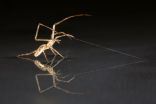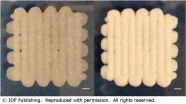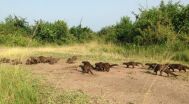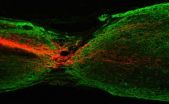(Press-News.org) Spiders travel across water like ships, using their legs as sails and their silk as an anchor, according to research published in the open access journal BMC Evolutionary Biology. The study helps explain how spiders are able to migrate across vast distances and why they are quick to colonise new areas.
Common spiders are frequently observed to fly using a technique called 'ballooning'. This involves using their silk to catch the wind which then lifts them up into the air. Ballooning spiders are estimated to move up to 30 km per day when wind conditions are suitable, helping in their quest for new habitats and resources.
This dispersal strategy, however, involves a significant risk. The airborne spider has little control over where it travels and could end up landing on water, which has been thought to be unsuitable for its survival.
Lead author Morito Hayashi from the Natural History Museum, London, UK, said: "Even Darwin took note of flying spiders that kept dropping on the Beagle miles away from the sea shore. But given that spiders are terrestrial, and that they do not have control over where they will travel when ballooning, how could evolution allow such risky behavior to be maintained?"
"We've now found that spiders actively adopt postures that allow them to use the wind direction to control their journey on water. They even drop silk and stop on the water surface when they want. This ability compensates for the risks of landing on water after the uncontrolled spider flights."
The researchers collected 325 adult spiders belonging to 21 common species from small islands in nature reserves in Nottinghamshire, UK. The spiders' behavior was observed on trays of water in reaction to pump-generated air, and this was compared to their reactions on dry surfaces.
Many of the spider species adopted elaborate postures, such as lifting up a pair of legs, to seemingly take advantage of the wind current whilst on the water surface. This allowed them to 'sail' in turbulent, still, fresh, and salt water conditions.
By releasing silk on water, the sailing spiders also seemed to act like ships dropping their anchors to slow down or stop their movement. This suggests that the silk may sometimes work as a dragline for the water-trapped spider to attach to floating objects or to the shore. These behavioral adaptations could allow spiders to survive encounters with aquatic environments.
The research team also found that the spiders that adopted 'ballooning' behavior for airborne dispersal were also the most eager and able 'sailors'. The association between the two behaviors may indicate the importance of ballooners also being able to sail, which could be invaluable when landing on water.
Co-author Sara Goodacre from the University of Nottingham, UK, added: "Being able to cope with water effectively 'joins the dots' as far as the spider is concerned. It can move from one land mass to another, and potentially across huge spatial scales through the air. If landing on water poses no problem then in a week or two they could be a long way away from where they started."
Sailing behavior could also be helpful in non-ballooning spiders to increase survival near wet areas and after rainfall, including flooding events.
INFORMATION:
The research is a collaborative work between Morito Hayashi (Natural History Museum, London, UK), Mohammed Bakkali (Universidad de Granada, Spain), Alexander Hyde (a British professional wildlife photographer) and Sara Goodacre (University of Nottingham, UK).
Media Contact
Joel Winston
Media Officer
BioMed Central
T: +44 (0)20 3192 2081
M: +44 (0)7766540147
E: Joel.Winston@biomedcentral.com
Notes to editor:
1. Hi-res photos of the sailing spiders are available here: http://bit.ly/1Jt2gJ7
Please credit Alex Hyde in any re-use.
2. Research article
Morito Hayashi, Mohammed Bakkali, Alexander Hyde & Sara L. Goodacre
Sail or Sink: Novel behavioural adaptations on water in aerially dispersing species
BMC Evolutionary Biology 2015
doi 10.1186/s12862-015-0402-5
After embargo, article available at journal website here: http://dx.doi.org/10.1186/s12862-015-0402-5
Please name the journal in any story you write. If you are writing for the web, please link to the article. All articles are available free of charge, according to BioMed Central's open access policy.
3. BMC Evolutionary Biology is an open access, peer-reviewed journal that considers articles on all aspects of molecular and non-molecular evolution of all organisms, as well as phylogenetics and palaeontology.
BMC Evolutionary Biology is part of the BMC series which publishes subject-specific journals focused on the needs of individual research communities across all areas of biology and medicine. We offer an efficient, fair and friendly peer review service, and are committed to publishing all sound science, provided that there is some advance in knowledge presented by the work.
4. BioMed Central is an STM (Science, Technology and Medicine) publisher which has pioneered the open access publishing model. All peer-reviewed research articles published by BioMed Central are made immediately and freely accessible online, and are licensed to allow redistribution and reuse. BioMed Central is part of Springer Science+Business Media, a leading global publisher in the STM sector. http://www.biomedcentral.com
Scientists have developed a new technique allowing the bioprinting at ambient temperatures of a strong paste similar to 'play dough' capable of incorporating protein-releasing microspheres.
The scientists demonstrated that the bioprinted material, in the form of a micro-particle paste capable of being injected via a syringe, could sustain stresses and strains similar to cancellous bone - the 'spongy' bone tissue typically found at the end of long bones.
This work, published today (3 July 2015) in the journal Biofabrication, suggests that bioprinting at ambient temperatures ...
A therapy that replaces the faulty gene responsible for cystic fibrosis in patients' lungs has produced encouraging results in a major UK trial.
One hundred and thirty six patients aged 12 and over received monthly doses of either the therapy or the placebo for one year.
The clinical trial reached its primary endpoint with patients who received therapy having a significant, if modest benefit in lung function compared with those receiving a placebo.
Patients from across England and Scotland participated, and were treated in two centres, Royal Brompton Hospital in ...
Banded mongooses take extraordinary risks to ensure that they find the right mate.
Female banded mongooses risk their lives to mate with rivals during pack 'warfare' and both males and females have also learned to discriminate between relatives and non-relatives to avoid inbreeding even when mating within their own social group.
Researchers from the University of Exeter and Liverpool John Moores University found that 18% of wild banded mongoose pups are fathered by males from rival packs.
Banded mongooses are found living in stable social groups across Central ...
For the first time gene therapy for cystic fibrosis has shown a significant benefit in lung function compared with placebo, in a phase 2 randomised trial published in The Lancet Respiratory Medicine journal. The technique replaces the defective gene response for cystic fibrosis by using inhaled molecules of DNA to deliver a normal working copy of the gene to lung cells.
"Patients who received the gene therapy showed a significant, if modest, benefit in tests of lung function compared with the placebo group and there were no safety concerns," said senior author Professor ...
LAWRENCE -- A new study that is the first to use Social Security Administration's personal income tax data tracking the same individuals over 20 years to measure individual lifetime earnings has confirmed significant long-term economic benefits of college education.
ChangHwan Kim, a University of Kansas researcher, said the research team was also able to account for shortcomings in previous studies by including factors such as gender, race, ethnicity, place of birth and high school performance that would influence a person's lifetime earnings and the probability of college ...
DALLAS, July 2, 2015 -- An emergency room rapid response plan for children can help diagnose stroke symptoms quickly, according to new research in the American Heart Association journal Stroke.
"Just as there are rapid response processes for adults with a possible stroke, there should be a rapid response process for children with a possible stroke that includes expedited evaluation and imaging or rapid transfer to a medical center with pediatric stroke expertise," said Lori Jordan, M.D., Ph.D., study senior author and an assistant professor of pediatrics and neurology ...
Researchers at the Hong Kong University of Science and Technology (HKUST) have found a way to stimulate the growth of axons, which may spell the dawn of a new beginning on chronic SCI treatments.
Chronic spinal cord injury (SCI) is a formidable hurdle that prevents a large number of injured axons from crossing the lesion, particularly the corticospinal tract (CST). Patients inflicted with SCI would often suffer a loss of mobility, paralysis, and interferes with activities of daily life dramatically. While physical therapy and rehabilitation would help the patients to ...
Washington, D.C. - July 2, 2015 - Male fruit flies infected with the bacterium, Wolbachia, are less aggressive than those not infected, according to research published in the July Applied and Environmental Microbiology, a journal of the American Society for Microbiology. This is the first time bacteria have been shown to influence aggression, said corresponding author Jeremy C. Brownlie, PhD, Deputy Head, School of Natural Sciences, Griffith University, Brisbane, Australia.
The research began with a discovery by University of Arizona student Elizabeth Bondy, an undergraduate ...
Astronomers are gearing up for high-energy fireworks coming in early 2018, when a stellar remnant the size of a city meets one of the brightest stars in our galaxy. The cosmic light show will occur when a pulsar discovered by NASA's Fermi Gamma-ray Space Telescope swings by its companion star. Scientists plan a global campaign to watch the event from radio wavelengths to the highest-energy gamma rays detectable.
The pulsar, known as J2032+4127 (J2032 for short), is the crushed core of a massive star that exploded as a supernova. It is a magnetized ball about 12 miles ...
MINNEAPOLIS - A new study suggests that genes may not be to blame for the increased risk of heart disease some studies have shown in people with migraine, especially those with migraine with aura. The research is published during Headache/Migraine Awareness Month in the inaugural issue of the journal Neurology® Genetics, an open access, or free to the public, online-only, peer-reviewed journal from the American Academy of Neurology. Aura are sensations that come before the headache, often visual disturbances such as flashing lights.
"Surprisingly, when we looked ...






